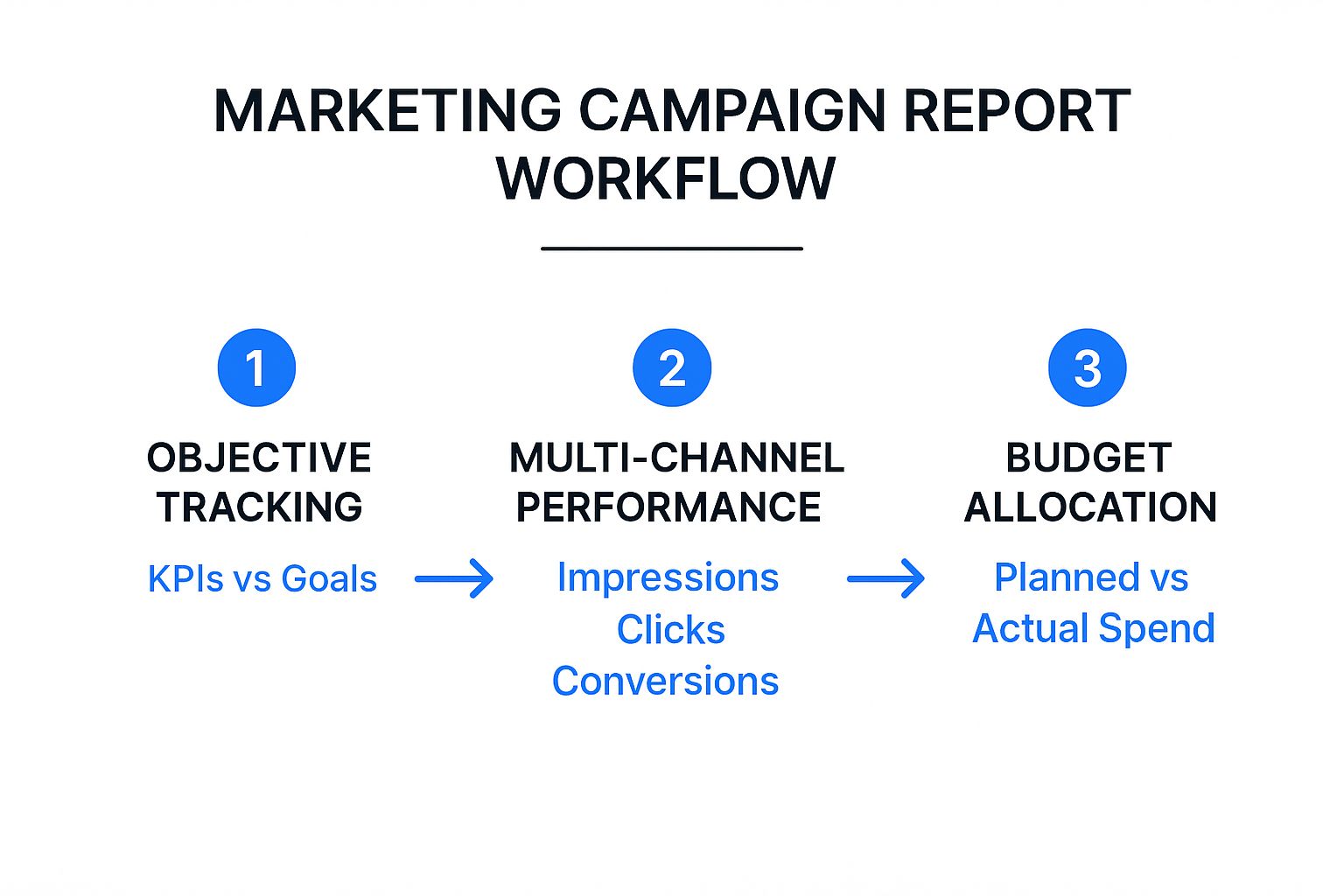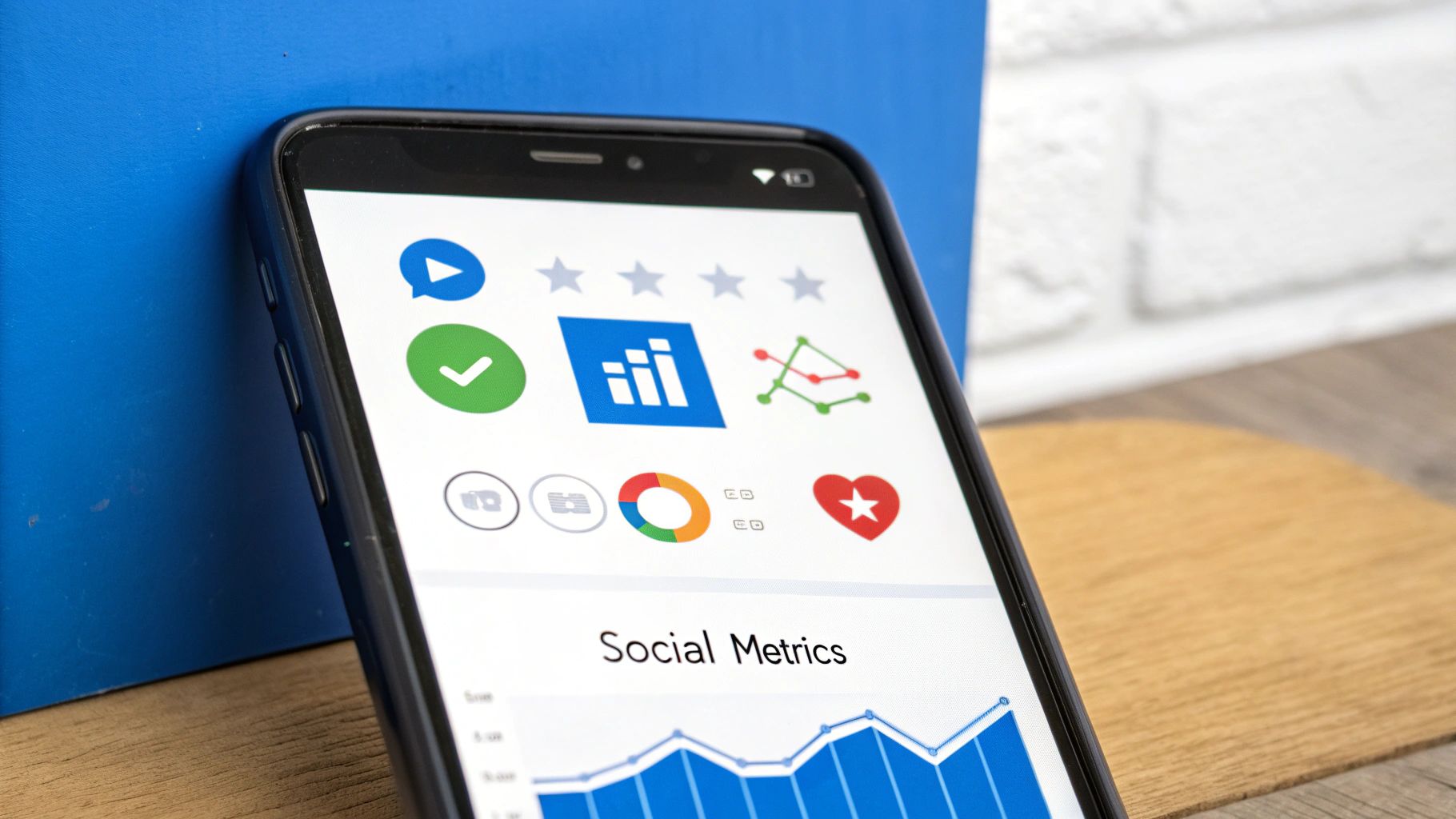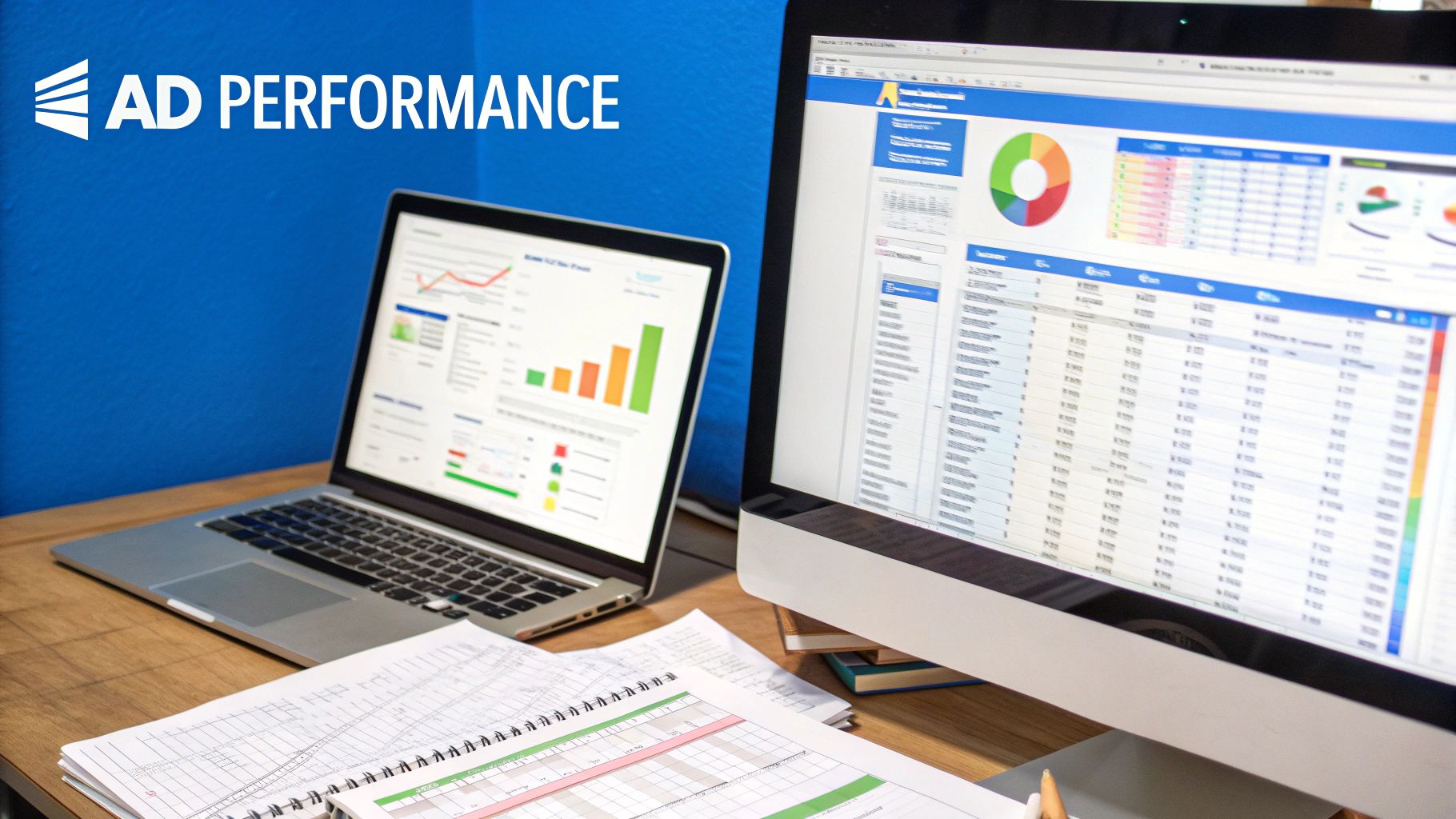Marketing data is only as valuable as the story it tells. Raw metrics-like click-through rates, conversion numbers, and traffic sources-are just data points. Without structure and analysis, they fail to reveal the strategic insights needed to justify budgets, pivot campaigns, and drive real growth. This is where a well-crafted marketing report transforms noise into actionable intelligence. It's the critical link between your team's daily efforts and the C-suite's demand for measurable ROI.
This guide provides a curated collection of powerful marketing report examples designed for different business needs. We will move beyond generic templates and surface-level dashboards. Instead, we will dissect each report to uncover the strategic thinking behind its structure. You will see not just what to track, but why it matters and how to present it for maximum impact.
For each example, we will break down:
From high-level campaign overviews to granular channel-specific analytics, these examples provide the blueprints for creating reports that don’t just get filed away-they get results.
A comprehensive marketing campaign report is the cornerstone of data-driven marketing, providing a 360-degree view of a campaign's performance from its initial goals to its final outcomes. Unlike a simple dashboard, this report synthesizes data from multiple channels to tell a complete story about what worked, what didn't, and why. It moves beyond vanity metrics to connect marketing activities directly to business objectives like revenue and customer acquisition.
This type of report is essential for justifying marketing spend and optimizing future strategies. For instance, Coca-Cola's 'Share a Coke' campaign analysis directly attributed a 2% sales lift in the U.S. to the campaign's success. Similarly, Nike’s report on the 30th-anniversary "Just Do It" campaign showed a remarkable 31% surge in online sales, proving the campaign's massive ROI. These examples highlight the power of connecting specific campaign elements to tangible business results.
To be effective, this report must be structured around the key performance indicators (KPIs) established during the campaign planning phase. This ensures you are measuring against predefined success benchmarks, not just reporting on available data.
The following infographic illustrates the core workflow for building a comprehensive campaign report, connecting objectives to performance and budget.

This process ensures that your analysis is always tied back to strategic goals and financial realities, making the report a powerful tool for decision-making. The final step, comparing planned versus actual spend, is critical for evaluating efficiency and planning future budgets. For teams looking to master this process, exploring advanced marketing campaign analytics can provide a significant competitive advantage.
A social media performance report is a specialized document that isolates and analyzes the effectiveness of a brand's presence across platforms like Instagram, Twitter, LinkedIn, and TikTok. It moves beyond follower counts to measure engagement, content effectiveness, and the direct impact of social activities on broader business goals. This report is crucial for understanding audience behavior, refining content strategy, and proving the value of social media investments.
This type of report allows marketers to pinpoint exactly what resonates with their audience. For example, Wendy's analysis of its humorous and bold Twitter strategy revealed a 3x increase in engagement compared to more traditional corporate messaging. Similarly, Chipotle's report on the #GuacDance challenge on TikTok demonstrated a direct line from viral social activity to a significant lift in digital orders, solidifying the platform's ROI. These marketing report examples show the power of targeted social media analysis.

An effective social media report must connect platform-specific metrics to high-level business objectives. This ensures you are not just tracking vanity metrics but are focused on activities that drive tangible results like lead generation or sales.
This structured approach transforms your report from a simple data summary into a strategic tool for decision-making. By regularly reviewing these focused reports, teams can quickly adapt their content and budget allocation for maximum impact. Companies can gain significant advantages by exploring targeted approaches, like those found in social media marketing for SaaS, to align social efforts directly with business growth.
An email marketing analytics report is a specialized document that dives deep into the performance of email campaigns, providing critical insights into subscriber engagement and conversion behavior. More than just a list of open and click rates, this report connects email efforts to tangible business goals like lead generation, sales, and customer retention. It’s the primary tool for optimizing email strategy, ensuring list health, and proving the channel's ROI.
This type of report is vital for any business that relies on email to nurture leads and communicate with customers. For example, BuzzFeed's detailed newsletter performance analysis directly informs its content strategy, ensuring they deliver what their audience wants to read. Similarly, Airbnb's reports on personalized email campaigns revealed a staggering 300% increase in bookings by tailoring recommendations to user behavior, highlighting the power of data-driven email personalization. These examples show how a focused report transforms email from a simple communication tool into a high-impact revenue driver.
An effective email marketing report must go beyond surface-level metrics to analyze the entire subscriber journey. It should be structured to answer key questions about engagement, conversion, and list quality, aligning with broader marketing objectives.
The report should also incorporate results from A/B tests on subject lines, calls-to-action, and content formats to provide clear, actionable guidance for future optimization. By systematically tracking what works, teams can continuously improve performance. For those looking to build a robust reporting framework, understanding advanced email marketing analytics can provide a deeper level of insight into subscriber behavior and campaign effectiveness.
An SEO Performance Report is a vital analysis of a website's organic search visibility, tracking the direct impact of optimization efforts on traffic, rankings, and business goals. This report translates technical SEO activities into tangible business outcomes, showing how improvements in keyword rankings and backlink profiles lead to increased organic leads and revenue. It serves as the primary tool for demonstrating the long-term value and ROI of search engine optimization.
This report is crucial for making informed decisions about content strategy and technical website improvements. For example, HubSpot's well-documented SEO strategy successfully grew its organic traffic by over 6x, a result meticulously tracked and analyzed in their performance reports. Similarly, Canva leverages detailed SEO reporting to manage its content-driven growth, which now attracts millions of monthly visitors from organic search. These examples of marketing reports showcase how SEO analytics drive sustainable business growth.
An effective SEO report must go beyond surface-level traffic numbers and connect performance to strategic objectives. It should be structured to answer not just "what happened?" but "why did it happen and what should we do next?". While your SEO Performance Report focuses on measurement, understanding the underlying strategies is crucial. Exploring various strategies to increase website traffic can help improve your SEO efforts.
This multi-faceted approach ensures the report provides a holistic view, linking technical health to on-page performance and ultimately to business impact. For SaaS companies looking to leverage this data, implementing dedicated SEO strategies for SaaS companies can turn these insights into a powerful customer acquisition channel.
A content marketing performance report provides a strategic evaluation of your content initiatives, moving far beyond simple traffic metrics to measure true business impact. This report analyzes how various content formats, from blog posts to videos, contribute to audience engagement, lead generation, and brand authority. It connects your content creation efforts directly to core business objectives, ensuring every piece of content has a purpose and delivers a return on investment.
This type of report is crucial for refining content strategy and justifying resource allocation. For example, Buffer's transparent blog strategy, which openly discusses business challenges and successes, grew their audience to over 6 million monthly visitors. Similarly, American Express’s OPEN Forum became a go-to resource for small business owners, building immense brand loyalty by providing valuable content instead of direct product pitches. These marketing report examples show how focusing on audience value through content translates into powerful business growth.
An effective content marketing report must tie performance back to the stages of the customer journey, from awareness to conversion. This ensures you are measuring the right metrics for each content piece and optimizing your strategy holistically, not just for top-of-funnel engagement.
This comprehensive analysis helps you understand not just what content performs well, but why. By tracking metrics across the entire funnel, you can build a more effective content engine that attracts, engages, and converts your target audience, making it an essential part of your collection of marketing report examples.
A paid advertising campaign report is a critical tool for any marketer investing in platforms like Google Ads, Facebook Ads, or LinkedIn. This report moves beyond surface-level metrics to dissect the efficiency and profitability of ad spend. It provides a granular analysis of how budget is being converted into leads, sales, and revenue, focusing on return on ad spend (ROAS) as the ultimate measure of success.
This type of report is essential for optimizing campaigns in real-time and scaling what works. For example, Dollar Shave Club's legendary launch video campaign reportedly generated 12,000 new customers in just 48 hours, a feat tracked and validated through meticulous paid ad reporting. Similarly, Warby Parker effectively used Facebook ad reports to refine its targeting, achieving a customer acquisition cost 50% lower than industry averages. These examples of marketing report examples show how precise tracking drives phenomenal growth.

An effective paid advertising report must be structured to answer one core question: is our ad spend profitable? To do this, it must connect campaign inputs like ad creative and audience targeting directly to bottom-line results.
A key best practice, popularized by experts like WordStream founder Larry Kim, is to compare Customer Lifetime Value (LTV) to CPA. A healthy LTV:CPA ratio (often 3:1 or higher) is a strong indicator of long-term profitability and sustainable growth. This strategic lens ensures you are not just acquiring customers, but profitable ones.
A market research and consumer insights report acts as a strategic compass, guiding a company's marketing efforts by illuminating market trends, consumer behavior, and the competitive landscape. This report synthesizes quantitative data like surveys and sales figures with qualitative insights from focus groups and interviews to build a rich, multi-dimensional picture of the market. It’s a foundational document that helps businesses identify untapped opportunities and mitigate potential risks before committing significant resources.
This type of report is crucial for making informed, high-stakes decisions. For example, Nielsen's consumer trend reports are instrumental for CPG brands in deciding which new products to launch. Similarly, Spotify's deep analysis of listening habits directly informs its hyper-personalized playlists and targeted advertising strategies, enhancing user experience and ad revenue. These reports move beyond simple data collection to deliver a narrative about consumer motivations and future market direction.
An effective market research report must translate raw data into actionable business intelligence. The structure should guide the reader from broad market observations to specific, strategic recommendations that align with business objectives.
Translating these findings into tangible marketing actions is the report's primary function. It ensures that product development, messaging, and channel selection are all grounded in a solid understanding of the target audience and the competitive environment, making it one of the most valuable marketing report examples for strategic planning.
A Marketing ROI and Attribution Report is a strategic financial analysis that directly connects marketing efforts to revenue. It moves beyond channel-specific metrics to map the entire customer journey, assigning value to each touchpoint that influenced a conversion. This report is crucial for understanding which channels and campaigns are truly driving growth, allowing for smarter budget allocation and optimized marketing strategies.
This type of analysis is vital for justifying marketing spend and proving its direct impact on the bottom line. For example, Salesforce uses multi-touch attribution models to visualize how various interactions, from a webinar to a blog post, contribute to closing a deal. Similarly, Shopify’s e-commerce attribution reports help online retailers understand which ads or social media posts lead directly to sales, enabling them to double down on profitable channels. These examples showcase how attribution provides the clarity needed to measure and maximize returns.
An effective ROI and attribution report requires sophisticated tracking and a clear understanding of different attribution models. The goal is to build a holistic picture of how marketing investments translate into revenue, not just leads or clicks.
By focusing on these components, the report becomes an indispensable tool for strategic planning. It answers the fundamental question: "What is the financial return on our marketing investment?" Teams that master this can transform their marketing function from a cost center into a proven revenue driver. For those looking to dive deeper, understanding the nuances of calculating marketing ROI is a critical next step.
We've journeyed through a comprehensive collection of marketing report examples, moving far beyond simple data dumps to uncover the strategic stories hidden within the numbers. From the granular detail of a paid advertising campaign report to the high-level overview of a comprehensive marketing ROI analysis, the core principle remains the same: a great report doesn't just present data; it drives decisive action.
The key is to transform raw metrics into a clear narrative. Each report we dissected, whether for SEO, social media, or email marketing, serves a distinct purpose. It answers critical business questions, validates strategic choices, and illuminates the path forward. Without this narrative layer, even the most data-rich report is just noise.
Mastering the art of the marketing report is a non-negotiable skill for any modern marketer, agency, or business leader. It is the mechanism that connects day-to-day tactical execution with high-level business objectives. Effective reporting builds trust with stakeholders, justifies budget allocations, and, most importantly, provides the clarity needed to pivot or persevere with confidence.
As you begin to build or refine your own reporting, remember these foundational takeaways from the marketing report examples we've explored:
Ultimately, the goal is to create a feedback loop where insights from one report directly inform the strategy for the next cycle. This iterative process of reporting, analyzing, and optimizing is the engine of sustainable growth. By adopting the structures and strategic mindsets from these examples, you are equipping your team to not only measure performance but to systematically improve it.
Ready to automate the most challenging parts of your reporting? The Marketing ROI and Attribution report examples show the power of precise tracking, and Cometly is the tool built to deliver it. Stop guessing and start knowing exactly which ads are driving sales with first-party, real-time tracking that feeds directly into your reports. Visit Cometly to see how you can achieve unparalleled clarity on your marketing ROI today.
Learn how Cometly can help you pinpoint channels driving revenue.
.svg)
Network with the top performance marketers in the industry